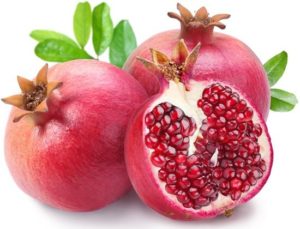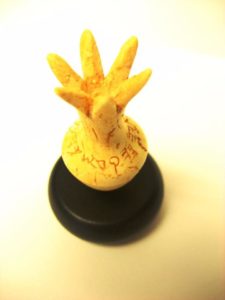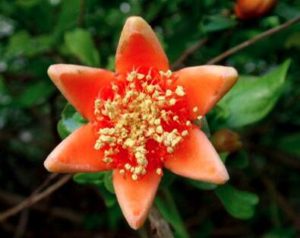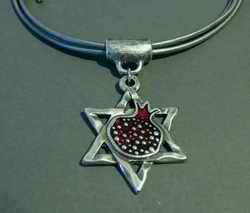 This weekend I will be celebrating my sixth Feast of Shavuot, and I am very blessed to be spending it with a family of Messianics who just happen to be some of the foremost Temple experts alive today. Am I excited? You have no idea! Okay, I just started crying, darnit. Let’s talk about one of the seven species that are traditionally eaten during Shavuot (Pentecost) and Sukkot (Feast of Tabernacles) because they are very representative of God’s blessings and the lives we are commanded to live. The traditions of the Feasts, I have come to find, are very much focused on (1) praising God through Scripture and Song, (2) honoring Him by recalling the glory of His Temple and those things which were done in order to worship Him there as an entire Nation, and (3) honoring Him by praising the blessings of the Land of Promise. Pomegranates definitely fall into all three categories–from the pomegranate imagery in the Song of Solomon to the remembrance of the adornment of the Temple and High Priestly garments with pomegranates and with the traditional eating of pomegranate during the Feasts. (I am blessed to be the one bringing pomegranate to the celebration this weekend)
This weekend I will be celebrating my sixth Feast of Shavuot, and I am very blessed to be spending it with a family of Messianics who just happen to be some of the foremost Temple experts alive today. Am I excited? You have no idea! Okay, I just started crying, darnit. Let’s talk about one of the seven species that are traditionally eaten during Shavuot (Pentecost) and Sukkot (Feast of Tabernacles) because they are very representative of God’s blessings and the lives we are commanded to live. The traditions of the Feasts, I have come to find, are very much focused on (1) praising God through Scripture and Song, (2) honoring Him by recalling the glory of His Temple and those things which were done in order to worship Him there as an entire Nation, and (3) honoring Him by praising the blessings of the Land of Promise. Pomegranates definitely fall into all three categories–from the pomegranate imagery in the Song of Solomon to the remembrance of the adornment of the Temple and High Priestly garments with pomegranates and with the traditional eating of pomegranate during the Feasts. (I am blessed to be the one bringing pomegranate to the celebration this weekend)
Generally, if one wants to know what a certain symbol means, listen to the people who use it and if they happened to write the Bible, check that out as well. Oftentimes the reasons are straightforward, simple, right out in the open, and self-evident.
If the golden altar [the layer] on which was only of the thickness of a denar lasted for many years and the fire had no power over it, how much more would that be the case with the transgressors in Israel who are as full of good deeds as a pomegranate [with seed], as it is said in Scripture: Thy temples are like a pomegranate, and R. Simeon b. Lakish remarked, `Read not, `Thy temples` but `Thy empty ones` [signifying] that even the worthless among you are as full of good deeds as a pomegranate [with seed]`. Eruvin 2.1-3
This commentary on the Song of Solomon might seem a bit confusing because it is written in what I like to call “ivory tower intellectual” but the gist of it is that the altar of incense was regarded as if it was composed of solid gold, even though it was only gold-plated. In the same way, even though all of Israel is not doing righteousness, the Nation is like that altar, gilded, and holy because God has set the people apart through Covenant. Israel, even counting the transgressors, is still filled with the “good deeds” of the Torah, like the pomegranate which is filled with seeds able to bring forth life and goodness.
Why does the Song of Solomon speak of pomegranates? Because the Song of Solomon is filled with Temple imagery–and Temple imagery is filled with Gan Eden (Garden in Eden) symbolism. Gan Eden was where man lived in harmony with God, and so the Temple was made to resemble God’s Garden. We know from II Chron 28:19 that David received all of the revelation of how to build and adorn the Temple from God, by the Spirit in writing–if only we still had that document it would be glorious.
“All this he made clear to me in writing from the hand of the Lord, all the work to be done according to the plan.”
I Kings 7, II Kings 25, II Chron 3, and 4 contain descriptions of the use of pomegranates in the adornment of the Temple (as does Jeremiah 52:22-23). Solomon did all of the work according to the plan, the tavnit, given to him by his father David.
In Exodus 28, we first see reference to the pomegranates embroidered into the hem of the high priest’s garment:
31-35 “You shall make the robe of the ephod all of blue. It shall have an opening for the head in the middle of it, with a woven binding around the opening, like the opening in a garment, so that it may not tear. On its hem you shall make pomegranates of blue and purple and scarlet yarns, around its hem, with bells of gold between them, a golden bell and a pomegranate, a golden bell and a pomegranate, around the hem of the robe. And it shall be on Aaron when he ministers, and its sound shall be heard when he goes into the Holy Place before the Lord, and when he comes out, so that he does not die.
 One of the most striking and beautiful artifacts ever uncovered is the probable top of the scepter carried by the High Priest, which dates to the 13th or 14th century BCE–to the time of the Exodus. Although once called a forgery, it has now been verified as authentic [1]. It carries the inscription “Holy to the Priest of the House of God” in Paleo Hebrew. It is representative of a pomegranate in an early stage of growth.
One of the most striking and beautiful artifacts ever uncovered is the probable top of the scepter carried by the High Priest, which dates to the 13th or 14th century BCE–to the time of the Exodus. Although once called a forgery, it has now been verified as authentic [1]. It carries the inscription “Holy to the Priest of the House of God” in Paleo Hebrew. It is representative of a pomegranate in an early stage of growth.
We see this scepter alluded to in Numbers 24:17.
I see him, but not now; I behold him, but not near: a star shall come out of Jacob, and a scepter shall rise out of Israel; it shall crush the forehead of Moab and break down all the sons of Sheth.
Yeshua, our High Priest in the Heavenlies, is that star who now bears the pomegranate scepter in the Heavenly Temple.
So why pomegranates? Well, pomegranates are one of the seven species listed in Deuteronomy 8:8, one of the seven agricultural blessings of the Promised Land. Each one of these species has a special place in Biblical symbolism, for example, the bowing over of wheat at the harvest represents humility, and I hardly need to mention the constant references to grapes and wine in Scripture! But pomegranates are a unique fruit, as anyone who has eaten one knows. It is chock full of seeds–and in ancient writings is symbolic of good deeds or in New Testament language, good fruit. When Paul was speaking of the fruit of the Spirit in Galatians 5:22-23, there is little doubt that he was referencing the pomegranate.
22-23 But the fruit of the Spirit is love, joy, peace, patience, kindness, goodness, faithfulness, gentleness, self-control; against such things there is no law.
The blessings, or lack thereof, in Scripture are also tied to the fecundity (fruitfulness, or fertility) of pomegranates.
 Joel 1:12 The vine dries up; the fig tree languishes. Pomegranate, palm, and apple, all the trees of the field are dried up, and gladness dries up from the children of man.
Joel 1:12 The vine dries up; the fig tree languishes. Pomegranate, palm, and apple, all the trees of the field are dried up, and gladness dries up from the children of man.
Haggai 2:19 Is the seed yet in the barn? Indeed, the vine, the fig tree, the pomegranate, and the olive tree have yielded nothing. But from this day on I will bless you.”
Interestingly, the Haggai verse was specifically spoken as a blessing to the people because on that day they had finally laid the foundation for the new Temple building as per God’s command in Haggai 1:7-11.
 Pomegranates, unlike the Menorah, were visible to the non-priestly Israelites and was therefore associated with the glory of God’s Temple far more than the Menorah, which they were never able to look at. Nowadays, that imagery is stylistically represented in the Star of David, the Magen David, the symbol of Israel, by a people fervently hoping for the Messiah to return – it is also a symbol of faith that one day the pomegranate would again be seen by all Israelites, once more adorning a Temple upon Mt Moriah, on the Temple Mount. (pendant can be purchased here since I used their pic it’s only fair I let you know where you can buy one)
Pomegranates, unlike the Menorah, were visible to the non-priestly Israelites and was therefore associated with the glory of God’s Temple far more than the Menorah, which they were never able to look at. Nowadays, that imagery is stylistically represented in the Star of David, the Magen David, the symbol of Israel, by a people fervently hoping for the Messiah to return – it is also a symbol of faith that one day the pomegranate would again be seen by all Israelites, once more adorning a Temple upon Mt Moriah, on the Temple Mount. (pendant can be purchased here since I used their pic it’s only fair I let you know where you can buy one)
[1]http://web.archive.org/web/20100115025132/http://www.bib-arch.org:80/news/news-ivory-pomegranate.asp
 This week we’re taking a break from our busy schedules to get together and discuss the meaning of Encroachment and the Judgement of Elohim from this week’s and next week’s Torah portions of Shela Lecha and Korah! What happens when we try to take someone else’s gifts for ourselves? What happens when we demand things that are not ours by right or give what God has given to one person, family or nation to another person, family or nation?
This week we’re taking a break from our busy schedules to get together and discuss the meaning of Encroachment and the Judgement of Elohim from this week’s and next week’s Torah portions of Shela Lecha and Korah! What happens when we try to take someone else’s gifts for ourselves? What happens when we demand things that are not ours by right or give what God has given to one person, family or nation to another person, family or nation?


